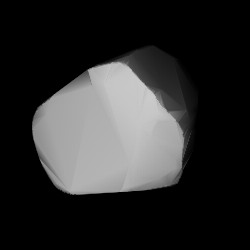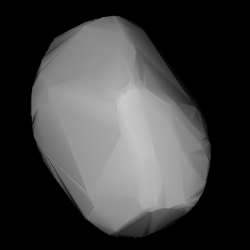Related Research Articles
2934 Aristophanes, provisional designation 4006 P-L, is a carbonaceous Veritasian asteroid from the outer regions of the asteroid belt, approximately 22 kilometers in diameter. It was discovered during the Palomar–Leiden survey in 1960, and later named after ancient Greek dramatist Aristophanes.
2436 Hatshepsut, provisional designation 6066 P-L, is a Hygiean asteroid from the outer asteroid belt, approximately 19 kilometers in diameter. It was discovered by Cornelis van Houten, Ingrid van Houten-Groeneveld and Tom Gehrels at Palomar Observatory on 24 September 1960. It was named for pharaoh Hatshepsut.
1810 Epimetheus, provisional designation 4196 P-L, is a stony Florian asteroid from the inner regions of the asteroid belt, approximately 8 kilometers in diameter.
37452 Spirit is a dark Hildian asteroid from the outermost region of the asteroid belt, approximately 9 kilometers in diameter.
39382 Opportunity is a dark Hilidan asteroid from the outermost region of the asteroid belt, approximately 7.5 kilometers in diameter. Discovered during the Palomar–Leiden survey at Palomar Observatory in 1960, it was named for NASA's Opportunity Mars rover.
8776 Campestris, provisional designation 2287 T-3, is a stony background asteroid from the central region of the asteroid belt, approximately 10 kilometers in diameter. It was discovered on 16 October 1977, by Dutch astronomer couple Ingrid and Cornelis van Houten at Leiden Observatory, and Dutch–American astronomer Tom Gehrels at the Palomar Observatory in California, United States. The asteroid was named for the tawny pipit, a shorebird.

9905 Tiziano, provisional designation 4611 P-L, is an asteroid from the inner regions of the asteroid belt, approximately 5 kilometers in diameter. Discovered during the Palomar–Leiden survey in 1960, the asteroid was named after Italian Renaissance painter Titian.
8121 Altdorfer, provisional designation 2572 P-L, is a stony Flora asteroid from the inner regions of the asteroid belt, approximately 2 kilometers in diameter. Discovered during the Palomar–Leiden survey in 1960, the asteroid was later named for Renaissance painter Albrecht Altdorfer.

1912 Anubis is a stony Koronis asteroid from the outer region of the asteroid belt, approximately 10 kilometers in diameter. It was named after the Egyptian deity Anubis.
1846 Bengt, provisional designation 6553 P-L, is a dark asteroid from the inner regions of the asteroid belt, approximately 11 kilometers in diameter. Discovered by the Palomar–Leiden survey in 1960, it was named for Danish astronomer Bengt Strömgren.

5196 Bustelli is a stony Eunomia asteroid from the central regions of the asteroid belt, approximately 6 kilometers kilometers in diameter. It was discovered on 30 September 1973, by Dutch astronomers Ingrid and Cornelis van Houten at Leiden, and Tom Gehrels the Palomar Observatory. The S-type asteroid was named after Italian-Swiss artist Franz Anton Bustelli.

11429 Demodokus is a mid-sized Jupiter trojan from the Greek camp, approximately 38 kilometers in diameter. It was discovered during the Palomar–Leiden survey at the Palomar Observatory in 1960 and later named after the blind singer Demodocus from Greek mythology. The dark Jovian asteroid has a longer-than average rotation period of 50.2 hours.
10660 Felixhormuth, provisional designation 4348 T-1, is a background asteroid from the outer regions of the asteroid belt, approximately 7 kilometers in diameter. It was discovered on 26 March 1971, by Dutch astronomer couple Ingrid and Cornelis van Houten at Leiden, on photographic plates taken by Dutch–American astronomer Tom Gehrels at Palomar Observatory in California, United States. The asteroid was named after German astronomer Felix Hormuth.
1777 Gehrels, also designated 4007 P-L, is a stony asteroid from the middle region of the asteroid belt, approximately 13 kilometers in diameter. It was discovered during the Palomar–Leiden survey in 1960, and named for astronomer Tom Gehrels, one of the survey's principal investigators and credited discoverer.
3047 Goethe, provisional designation 6091 P-L, is a bright background asteroid from the central regions of the asteroid belt, approximately 6 kilometers in diameter. It was discovered on 24 September 1960, by Dutch astronomer couple Ingrid and Cornelis van Houten on photographic plates taken by Dutch–American astronomer Tom Gehrels at the Palomar Observatory in California, United States. The asteroid was named after German poet Johann Wolfgang von Goethe.
2003 Harding, provisional designation 6559 P-L, is a carbonaceous Eoan asteroid from the outer regions of the asteroid belt, approximately 18 kilometers in diameter. It was discovered during the Palomar–Leiden survey on 24 September 1960, by astronomers Ingrid and Cornelis van Houten at Leiden, and Tom Gehrels at Palomar, California. The asteroid was later named after astronomer Karl Ludwig Harding.
10249 Harz, provisional designation 9515 P-L, is a background asteroid from the central regions of the asteroid belt, approximately 3.5 kilometers in diameter. It was discovered on 17 October 1960, by Ingrid and Cornelis van Houten at Leiden, and Tom Gehrels at Palomar Observatory in California, United States. The assumed S-type asteroid is likely elongated and has a short rotation period of 3.63 hours. It was named after the German mountain range Harz.
1924 Horus, provisional designation 4023 P-L, is a dark asteroid from the inner regions of the asteroid belt, approximately 12 kilometers in diameter. Discovered during the Palomar–Leiden survey in 1960, it was later named after Horus from Egyptian mythology.
1776 Kuiper, provisional designation 2520 P-L, is a dark Eoan asteroid from the outer region of the asteroid belt, approximately 38 kilometers in diameter.
(1965) van de Kamp, provisional designation 2521 P-L, is a stony asteroid from the central region of the asteroid belt, approximately 12 kilometers in diameter. It was discovered on 24 September 1960, by Dutch astronomer couple Ingrid and Cornelis van Houten at Leiden Observatory, on photographic plates taken by Dutch–American astronomer Tom Gehrels at the U.S Palomar Observatory, California. It was later named after Dutch astronomer Peter van de Kamp.
References
- 1 2 3 4 5 6 7 "JPL Small-Body Database Browser: 1923 Osiris (4011 P-L)" (2016-08-18 last obs.). Jet Propulsion Laboratory . Retrieved 14 June 2017.
- ↑ "Osiris". Lexico UK English Dictionary. Oxford University Press. Archived from the original on 21 March 2020.
- 1 2 3 Schmadel, Lutz D. (2007). "(1923) Osiris". Dictionary of Minor Planet Names – (1923) Osiris. Springer Berlin Heidelberg. p. 154. doi:10.1007/978-3-540-29925-7_1924. ISBN 978-3-540-00238-3.
- 1 2 3 "1923 Osiris (4011 P-L)". Minor Planet Center. Retrieved 14 June 2017.
- 1 2 3 Masiero, Joseph R.; Mainzer, A. K.; Grav, T.; Bauer, J. M.; Cutri, R. M.; Nugent, C.; et al. (November 2012). "Preliminary Analysis of WISE/NEOWISE 3-Band Cryogenic and Post-cryogenic Observations of Main Belt Asteroids". The Astrophysical Journal Letters. 759 (1): 5. arXiv: 1209.5794 . Bibcode:2012ApJ...759L...8M. doi:10.1088/2041-8205/759/1/L8 . Retrieved 14 June 2017.
- ↑ "New Names of Minor Planets" (PDF), Minor Planet Circular , no. MPC 5013, Cambridge, Mass: Minor Planet Center, 1 November 1979, ISSN 0736-6884
- ↑ "LCDB Data for (1923) Osiris". Asteroid Lightcurve Database (LCDB). Retrieved 14 June 2017.
- ↑ "MPC/MPO/MPS Archive". Minor Planet Center. Retrieved 14 June 2017.